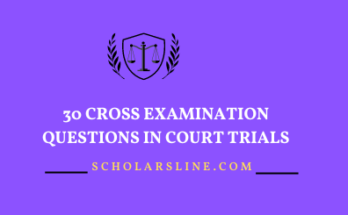How to Prepare a Witness for Testimony
Introduction:
Testifying as a witness in a legal proceeding can be a daunting experience for many individuals. Whether it’s a criminal trial, civil lawsuit, or any other legal matter, witnesses play a crucial role in presenting facts and evidence to the court. Proper preparation is essential to ensure that the witness is able to effectively communicate their testimony and withstand cross-examination. In this article, we will delve into the detailed steps and strategies involved in preparing a witness for testimony.
1. Establish Trust and Communication:
Before diving into the details of the case, it’s essential to establish a rapport with the witness. Building trust and ensuring open communication will help the witness feel more comfortable and confident during the preparation process. Create a supportive environment where the witness feels free to ask questions and express any concerns they may have.
2. Understand the Case:
The first step in preparing a witness is to thoroughly understand the case and the role of the witness within it. Review all relevant documents, including witness statements, deposition transcripts, police reports, and any other evidence pertaining to the case. This will provide context and help identify key points that the witness needs to address during testimony.
3. Educate the Witness:
Provide the witness with a clear understanding of the legal process and what to expect during their testimony. Explain the importance of honesty, clarity, and consistency in their statements. Make sure the witness understands their rights and obligations as a witness, including the oath to tell the truth.
4. Review Testimony:
Go over the witness’s testimony in detail, focusing on the sequence of events, dates, times, and any other relevant details. Help the witness recall specific incidents or conversations related to the case. Encourage the witness to be as accurate and specific as possible in their recollection.
5. Practice Questioning:
Conduct mock questioning sessions to simulate the experience of being examined and cross-examined in court. Prepare a list of potential questions that the opposing counsel may ask and help the witness formulate clear and concise responses. Provide feedback and guidance on how to handle difficult or probing questions.
6. Address Emotional Preparedness:
Testifying in court can be emotionally taxing for some witnesses. Address any anxiety or stress the witness may be experiencing and provide support to help them manage their emotions during testimony. Encourage the witness to take breaks if needed and remind them to stay composed and focused while on the stand.
7. Discuss Courtroom Etiquette:
Review courtroom etiquette with the witness, including how to address the judge, attorneys, and jury. Emphasize the importance of maintaining a respectful and professional demeanor at all times. Provide guidance on body language, tone of voice, and other non-verbal cues that can impact the perception of the witness.
8. Final Preparations:
In the days leading up to the testimony, conduct final rehearsals to reinforce key points and ensure that the witness feels confident and prepared. Remind the witness to dress appropriately for court and arrive on time. Provide any additional support or resources that may be needed on the day of testimony.
Conclusion:
Preparing a witness for testimony is a collaborative process that requires careful planning, communication, and attention to detail. By following these steps and strategies, attorneys can help witnesses feel empowered and ready to effectively communicate their testimony in court. Proper preparation not only enhances the credibility of the witness but also strengthens the overall presentation of the case.
READ ALSO: 30 Cross Examination Questions in Court Trials
How to Declare a Witness as a Hostile Witness
Declaring a witness as hostile is a legal maneuver used during trial proceedings when a witness demonstrates unwillingness or hostility towards the party who called them to testify. Designating a witness as hostile allows the attorney to ask leading questions during direct examination, which is typically not allowed. Here’s a step-by-step guide on how to declare a witness as hostile:
1. Recognize Hostile Behavior: Before declaring a witness as hostile, it’s important to recognize signs of hostility or unwillingness. This may include evasiveness, contradictory statements, or overt antagonism towards the attorney or the party they represent.
2. Document Hostile Behavior: Make a record of the witness’s behavior by noting specific instances of hostility or unwillingness during their testimony. This documentation will serve as evidence to support the request to declare the witness as hostile.
3. Request Permission from the Court: During the witness’s testimony, the attorney should respectfully request permission from the presiding judge to declare the witness as hostile. This can be done by stating the reasons for the request and providing examples of the witness’s behavior that demonstrate hostility or unwillingness.
4. Present Legal Basis: Provide legal grounds for declaring the witness as hostile, citing relevant rules of evidence or case law that support the request. In most jurisdictions, the rules of evidence allow for witnesses to be declared hostile under certain circumstances, such as when they are adverse or hostile to the party calling them to testify.
5. Demonstrate Need for Leading Questions: Explain to the court why it is necessary to ask leading questions during the direct examination of the hostile witness. Leading questions are questions that suggest the answer or contain assumptions, and they are typically not allowed during direct examination. However, in the case of a hostile witness, leading questions may be necessary to elicit truthful or relevant testimony.
6. Opposing Counsel’s Response: After the request is made, opposing counsel may have an opportunity to respond or object to the request to declare the witness as hostile. They may argue against the declaration by disputing the characterization of the witness’s behavior or by presenting counterarguments.
7. Judge’s Ruling: The presiding judge will ultimately decide whether to grant the request and declare the witness as hostile. The judge will consider the arguments presented by both parties and make a ruling based on the applicable law and the specific circumstances of the case.
8. Conduct Direct Examination with Leading Questions: If the request is granted and the witness is declared hostile, the attorney can proceed with the direct examination by asking leading questions. Leading questions should be phrased in a way that suggests the desired answer and helps to control the witness’s testimony.
9. Maintain Professionalism: Throughout the process, it’s important for attorneys to maintain professionalism and adhere to courtroom decorum. While the declaration of a witness as hostile may lead to more confrontational questioning, it should be done in a respectful manner and with the goal of eliciting truthful and relevant testimony.
By following these steps and adhering to legal procedures, attorneys can effectively declare a witness as hostile and navigate the process of questioning them during trial proceedings.
Thanks for going through this post; How to Prepare a Witness for Testimony




